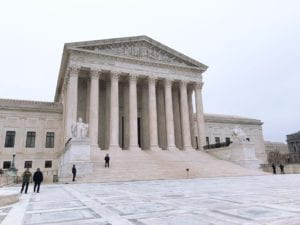
By Gayoung Lee
The Supreme Court of the United States is home to three Pokéstops.
At least, that’s what I heard from the boys I walked behind on my way there. At the Supreme Court, you can also catch several Eevees and five Pikachus. It’s a Pokémon Go paradise.
But I digress. When I was made to visit the Supreme Court as part of an assignment for Journalism Ethics, I did not expect my trip to be so rowdy. I stumbled into this group of 50-something tourists as soon as I left Union Station, and ended up staying with them for the entirety of my visit. I was lucky, though, because it turned out that these tourists had booked a guided tour in the main courtroom. And so I was able to join them and listen to the tour guide explain everything about the courtroom.
The Supreme Court was right across the U.S. Capitol, separated by a wide courtyard in front of the Greeks-style courthouse, with a basketball court on the roof. Apparently, the justices and their law clerks like to play basketball and hold fitness sessions there.
Visitors are not allowed to use the huge staircase that leads to the main gates of the Supreme Court. Our group entered from the side, went through a security check, and waited for our tour session, which was supposed to start at 1:30.
The ground floor has three halls. The middle one has an exhibition on the general history of the Supreme Court, which leads to a statue of Justice John Marshall. Behind the statue is a special exhibit on Sandra Day O’Connor, the first woman to be appointed an associate justice of the Supreme Court. On the walls of the other two corridors are portraits of all the justices, group portraits of different court eras, a cafeteria, and a gift shop. I was looking at the justice portraits when the security guards notified us our session was about to start. We were instructed not to take out our phones, as all digital devices were prohibited in the courtroom, and to stay quiet, which they had to emphasize several times. Let me just say: The Pokémon Go boys were not happy to give up their hunt.
I climbed up a set of stairs to find a huge marble room, at the corner of which was a small opening that led to the main courtroom. The room was pretty dark, with eight marble columns on either side (Italian marble, unlike the pillars behind the justices’ seats, which were 100% American marble). We sat behind a small wooden fence that separated the visitors and special guests from the justices, attorneys, clerks, etc. Once we settled down, the tour guide explained to us the analytics behind the workings of the Supreme Court, how the building came to be, and what each component of the interior meant, or didn’t – the gold-plated flowers on the ceiling are there simply because the architect thought they would be pretty.
The children in the group were divided in their interest, with some fervently asking questions and others looking like they were on the verge of falling asleep. Nevertheless, the high-pitched voices of the excited kids bumped up the brightness of the room by a tiny bit, and it was interesting to learn what these kids felt about the Supreme Court. Were they aware that this small, dark room had been shaping their lives hundreds of years before they were born (although the current room was built in the 1930s)? Would any of them ever end up in this court? Which side would they be on?
As I was leaving the building, the Pokémon Go boys were next to me again, their experience forgotten, excited about their gaming prospects. But there were some other children that wore more serious faces, and I reveled again at how much this seemed like a microcosm of American society: People have different levels of engagement with politics and social issues, but then again, who knows? Perhaps one of those Pokemon boys could be the next Chief Justice. Perhaps the serious-looking kids will become disenchanted with politics altogether. I only realized I had been grimacing over these questions when the guide told us the lecture was over. Maybe it was a bit strange for me to suddenly wonder about these things, but I think those are the kinds of thoughts a place like the Supreme Court courtroom makes you ponder – the place itself symbolizes the possibilities of the United States, after all!
Photo by Gayoung Lee
Aw, this was an exceptionally nice post. Taking the time and actual effort to generate a top notch article… but what can I say… I put things off a whole lot and don’t seem to get anything done.